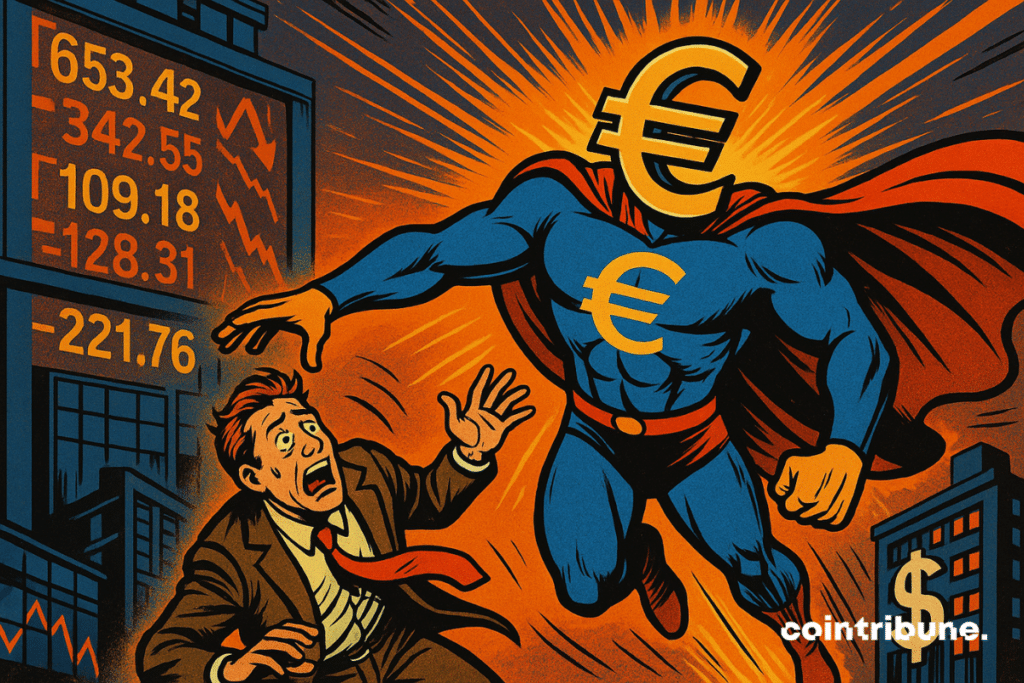Fall Of The Dollar Against The Euro: Here’s Why This Is Just The Beginning
Since the beginning of the year, the dollar has collapsed against the euro and other major currencies. A trend that seems far from over. Markets are adjusting to an uncertain geopolitical context, fueled by the economic decisions of the Trump administration. How far will the greenback’s plunge go?

In Brief
- The dollar has lost more than 9% against the euro since January, a trend that is accelerating.
- Donald Trump’s aggressive trade policy is fueling a massive loss of confidence.
- Investors are turning away from American assets, increasing pressure on the currency.
- Several major banks anticipate the euro above 1.20 dollars by the end of 2025.
The American Dollar Losing Momentum in the Markets
The dizzying fall of the dollar finds its roots in the missteps of the Trump administration. The Organisation for Economic Co-operation and Development (OECD) on Monday lowered its US growth forecasts to 1.6% for 2025, down from 2.2% previously and 2.8% in 2024. This drastic revision directly reflects the impact of tariffs announced by Donald Trump.
“While new tariffs may encourage more production in the United States, the rise in import prices will reduce consumers’ real incomes,” explains the OECD.
The international organization points to an economic paradox: tariffs meant to protect the US economy end up strangling it.
Trump’s hesitation on his trade policy creates major uncertainty. Using tariffs as a diplomatic weapon has not only antagonized trade partners but also shaken international investor confidence. This political instability results in a massive flight of capital to safer havens.
Trump’s budget plan, his famous “big, beautiful bill,” further worsens the situation. Goldman Sachs warns that this plan will result in prolonged budget deficits, fueling imbalances in the US current account. An explosive cocktail undermining the dollar’s credibility.
A Dollar Weakened for the Long Haul!
Bank of America identifies the central phenomenon: “In recent weeks, the dominant market theme has been global investors reassessing their significant exposures to the dollar.” This massive “portfolio rotation” sees capital fleeing American assets to redeploy in Europe.
A market paradox perfectly illustrates this distrust. Since April, US bond yields rose from 4% to 4.6%, while the dollar fell 5%. Normally, rising rates strengthen a currency. Here, they accelerate investor flight.
Deutsche Bank feared in April “a crisis of confidence” in the US currency. Today, the German bank believes “the damage is done.”
Trump’s threats against Jerome Powell, Fed Chair, added another layer of uncertainty. UBS highlights that “even discussing the Fed’s independence has increased extreme risks.”
This confidence crisis goes beyond the economic sphere. It reflects a profound questioning of American hegemony. Investors anticipate a multipolar world where the dollar will no longer be the absolute reference. This anticipation is becoming a self-fulfilling prophecy.
Towards a Euro at 1.25 Dollars?
Major banks’ forecasts converge towards a lasting strengthening of the euro. Morgan Stanley forecasts 1.25 dollars by 2026, up from 1.14 currently. Deutsche Bank sees the euro at 1.20 dollars at the end of 2025, then 1.25 in December 2026. Nomura anticipates 1.20 dollars by the end of this year.
This convergence reflects a structural shift. Europe is moving towards budget expansion, with Germany lifting its debt brake to increase defense spending. Meanwhile, the eurozone shows growth above 1%, contrasting with the deteriorated US outlook.
Bank of America warns that “any short-term dollar increase will ultimately be seen as a selling opportunity.” This phrase sums up the market sentiment: the dollar is no longer viewed as a safe haven but as an asset to be sold.
Monetary policy intensifies this trend. The Fed hesitates to cut rates as long as inflation remains high. Conversely, the European Central Bank has more room to maneuver. This monetary divergence favoring Europe enhances the euro’s attractiveness.
On the Brink of a Global Monetary Earthquake
The dollar is no longer what it used to be. This decline, fueled by poorly calibrated political choices, could turn into a structural trend.
As Voltaire said, “a paper currency, based solely on trust in the government issuing it, always ends up returning to its intrinsic value, that is, zero.” A visionary statement gaining particular relevance today.
Dedollarization is no longer a geopolitical fantasy but a tidal wave. And no, it is neither the euro nor another fiat currency that will naturally take over from the dollar – at least, not a traditional currency.
In this context of increasing monetary instability, it might be time to consider alternatives. Bitcoin, for example, deserves your full attention. Away from banking dogmas, it could well become a preservation tool in case of a systemic rupture, now almost inevitable.
Maximize your Cointribune experience with our "Read to Earn" program! For every article you read, earn points and access exclusive rewards. Sign up now and start earning benefits.
Passionné par le Bitcoin, j'aime explorer les méandres de la blockchain et des cryptos et je partage mes découvertes avec la communauté. Mon rêve est de vivre dans un monde où la vie privée et la liberté financière sont garanties pour tous, et je crois fermement que Bitcoin est l'outil qui peut rendre cela possible.
The views, thoughts, and opinions expressed in this article belong solely to the author, and should not be taken as investment advice. Do your own research before taking any investment decisions.